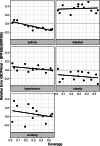Small-area estimation for public health surveillance using electronic health record data: reducing the impact of underrepresentation
- PMID: 35945537
- PMCID: PMC9364501
- DOI: 10.1186/s12889-022-13809-2
Small-area estimation for public health surveillance using electronic health record data: reducing the impact of underrepresentation
Abstract
Background: Electronic Health Record (EHR) data are increasingly being used to monitor population health on account of their timeliness, granularity, and large sample sizes. While EHR data are often sufficient to estimate disease prevalence and trends for large geographic areas, the same accuracy and precision may not carry over for smaller areas that are sparsely represented by non-random samples.
Methods: We developed small-area estimation models using a combination of EHR data drawn from MDPHnet, an EHR-based public health surveillance network in Massachusetts, the American Community Survey, and state hospitalization data. We estimated municipality-specific prevalence rates of asthma, diabetes, hypertension, obesity, and smoking in each of the 351 municipalities in Massachusetts in 2016. Models were compared against Behavioral Risk Factor Surveillance System (BRFSS) state and small area estimates for 2016.
Results: Integrating progressively more variables into prediction models generally reduced mean absolute error (MAE) relative to municipality-level BRFSS small area estimates: asthma (2.24% MAE crude, 1.02% MAE modeled), diabetes (3.13% MAE crude, 3.48% MAE modeled), hypertension (2.60% MAE crude, 1.48% MAE modeled), obesity (4.92% MAE crude, 4.07% MAE modeled), and smoking (5.33% MAE crude, 2.99% MAE modeled). Correlation between modeled estimates and BRFSS estimates for the 13 municipalities in Massachusetts covered by BRFSS's 500 Cities ranged from 81.9% (obesity) to 96.7% (diabetes).
Conclusions: Small-area estimation using EHR data is feasible and generates estimates comparable to BRFSS state and small-area estimates. Integrating EHR data with survey data can provide timely and accurate disease monitoring tools for areas with sparse data coverage.
Keywords: Asthma; Behavioral risk factor surveillance system; Diabetes mellitus; Hypertension; Obesity; Population surveillance; Smoking.
© 2022. The Author(s).
Conflict of interest statement
The authors declare that they have no competing interests.
Figures



Similar articles
-
Electronic Health Records Versus Survey Small Area Estimates for Public Health Surveillance.Am J Prev Med. 2024 Jul;67(1):155-164. doi: 10.1016/j.amepre.2024.02.018. Epub 2024 Mar 4. Am J Prev Med. 2024. PMID: 38447855
-
State and Local Chronic Disease Surveillance Using Electronic Health Record Systems.Am J Public Health. 2017 Sep;107(9):1406-1412. doi: 10.2105/AJPH.2017.303874. Epub 2017 Jul 20. Am J Public Health. 2017. PMID: 28727539 Free PMC article.
-
Weighted EHR-based prevalence estimates for hypertension at the state and local levels in Louisiana.BMC Public Health. 2025 Feb 3;25(1):432. doi: 10.1186/s12889-025-21633-7. BMC Public Health. 2025. PMID: 39901106 Free PMC article.
-
Utilization of Electronic Health Records for Chronic Disease Surveillance: A Systematic Literature Review.Cureus. 2023 Apr 22;15(4):e37975. doi: 10.7759/cureus.37975. eCollection 2023 Apr. Cureus. 2023. PMID: 37223147 Free PMC article. Review.
-
Adult patient access to electronic health records.Cochrane Database Syst Rev. 2021 Feb 26;2(2):CD012707. doi: 10.1002/14651858.CD012707.pub2. Cochrane Database Syst Rev. 2021. PMID: 33634854 Free PMC article.
Cited by
-
Addressing Information Biases Within Electronic Health Record Data to Improve the Examination of Epidemiologic Associations With Diabetes Prevalence Among Young Adults: Cross-Sectional Study.JMIR Med Inform. 2024 Oct 1;12:e58085. doi: 10.2196/58085. JMIR Med Inform. 2024. PMID: 39353204 Free PMC article.
-
"Cultural" Variation in Antibiotic Prescribing: Have Regional Differences Had Their Day?Open Forum Infect Dis. 2023 Feb 8;10(2):ofad025. doi: 10.1093/ofid/ofad025. eCollection 2023 Feb. Open Forum Infect Dis. 2023. PMID: 36776775 Free PMC article. No abstract available.
-
Community-Engaged Survey Approach to Pandemic Impacts on Marginalized Communities, Massachusetts, 2020-2021.Am J Public Health. 2024 Oct;114(S7):S599-S609. doi: 10.2105/AJPH.2024.307800. Epub 2024 Aug 28. Am J Public Health. 2024. PMID: 39197134 Free PMC article.
-
Validation of a small-area model for estimation of smoking prevalence at a subnational level.Tob Induc Dis. 2023 Sep 1;21:112. doi: 10.18332/tid/169683. eCollection 2023. Tob Induc Dis. 2023. PMID: 37664442 Free PMC article.
-
Addressing Selection Biases within Electronic Health Record Data for Estimation of Diabetes Prevalence among New York City Young Adults: A Cross-Sectional Study.BMJ Public Health. 2024;2(2):e001666. doi: 10.1136/bmjph-2024-001666. BMJ Public Health. 2024. PMID: 39568629 Free PMC article.
References
-
- Chicago Health Atlas. http://www.chicagohealthatlas.org/. Accessed 10 Jan 2021.
Publication types
MeSH terms
LinkOut - more resources
Full Text Sources
Medical

